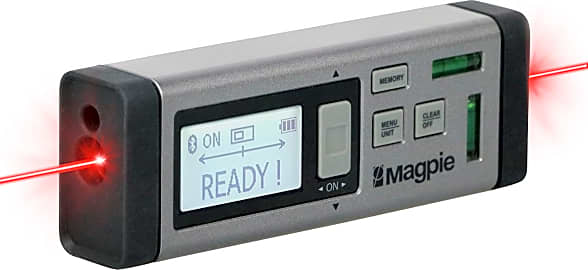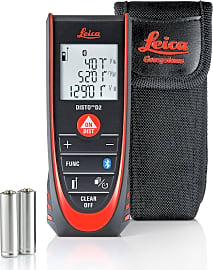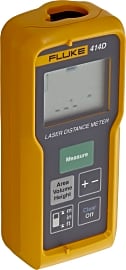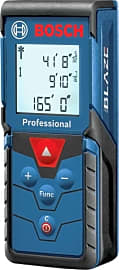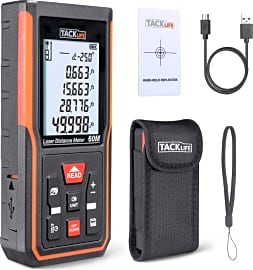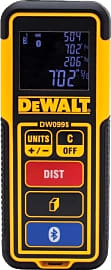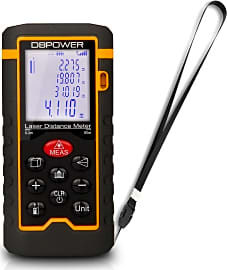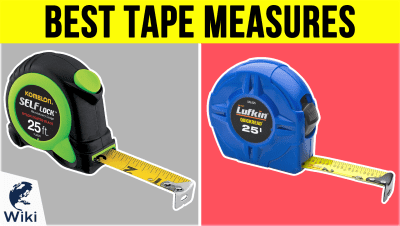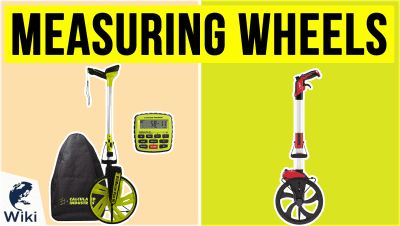The 10 Best Laser Measures

This wiki has been updated 44 times since it was first published in June of 2015. Tape measures are so 20th century. Step into the future with one of these laser models. Don't ask us how (it has something to do with Pythagoras), but some of them can even measure things they can't see. Contractors, electricians and DIYers will want to grab one immediately. They are perfect for any type of construction work, home remodeling, and real estate appraisals. When users buy our independently chosen editorial choices, we may earn commissions to help fund the Wiki.
Editor's Notes
November 10, 2020:
A laser measure's primary function is to accurately ascertain the measurements of distance without having to fumble around with a flimsy tape measure or a bulky measuring wheel. Additional features allow them to calculate surfaces and volumes, while the most up to date models now use Bluetooth to send data in real-time to mobile devices.
In the previous update, Bluetooth connectivity was the biggest improvement to be seen in these laser measures, however, now even some budget models feature this kind of connectivity as standard. The latest technology has brought digital cameras, color screens, and enhanced data exporting to these advanced tools. In this update, we have replaced some outdated options with the latest models and removed others that are no longer available. The DeWalt DW03050 was switched for the Dewalt DW099S which is just as durably made and now has Bluetooth. The Suaoki S9 was a good budget option, but is no longer available, so in its place, we selected the Atolla Meter, which has a 200-foot range and an IP54 protection rating, making it dust and splash-proof. Tacklife has brought out a new version of their Tacklife HD60 in the Tacklife S5-60, featuring an enhanced range, a rechargeable lithium-ion battery, and improved memory.
Of the three Bosch models on the list, we replaced the Bosch Blaze One with the latest Bosch Blaze Pro. It was, and still is, a cheaper option than most from this reputable company, and is notable for its easy to use one-button operation. The Bosch GLM 100C has been discontinued, and in its place is the much improved Bosch GLM400CL, featuring a 5 MP camera, a built-in inclinometer for measuring angles, and a large memory that can store 600 images. The Bosch GLR825 previously had the longest range on our list at 825 feet. We decided to replace it with the Leica Disto S910, a true powerhouse with a 1000 foot range and a touch screen. It also comes with a versatile, smart base that can be used as a marker for measuring between any two points. On the downside, the Leica is expensive, and therefore more of a dedicated commercial option.
January 31, 2019:
We wanted to make sure to include laser measures in a variety of price ranges and with varying levels of functionality to ensure both the home DIYer and professional contractor can find a model well-suited to their needs. As you can imagine with anything that is used to measure distance, accuracy was a top priority for use, as was overall build quality.
Laser Measures Versus Traditional Tape Measures
If you need to take measurements constantly throughout a project, saving a minute or two on every measurement can allow you to get a job done considerably quicker.
When using a measure, there are three main factors one might consider most important to getting the job done. Obviously accuracy tops the chart. If your measurements aren't accurate, nothing else matters. Followed by accuracy, it is a toss up whether convenience or speed is the next most vital aspect, but there is no arguing that one wants a tool that allows them to get accurate measurements quickly, and in a variety of settings. Let's take a moment to consider each of the following points to see how a laser measure can far surpass traditional measures in every category.
Accuracy - Consider the two main reasons a measurement comes out wrong; misreading the ruler and starting or ending the measurement in the wrong spot. With a laser measure, it is nearly impossible to misread the ruler as it is displayed in a digital format. Most laser measures also allow you to choose the measurement unit, so you can see it in metric or imperial and in units as small as a millimeter or as large as a meter.
Often people using a traditional tape measure may accidentally start the measurement or end the measurement a couple of millimeters off the intended start or end point. This is especially true when trying to measure a distance that is a bit outside of your reach. For some applications, a couple of millimeters may not matter, but in situations where precision is the difference between getting the job done correctly and having to redo it, this can be a vital time saver.
Speed - If you need to take measurements constantly throughout a project, saving a minute or two on every measurement can allow you to get a job done considerably quicker. With a laser measure, all you have to do is point and click, and you have the result in seconds. You don't need to walk to and from the starting and end points or climb a ladder if you are taking a measurement from floor to ceiling.
Convenience - A laser measure allows you take long range measurements without the assistance of a helper. You can also use it with one hand, which allows you to have a hand free to take down notes as needed. Another fantastic feature of many laser measures is the ability to get an accurate measurement, even when there is no line of sight between the start and end points. You can use the measure to record the distance of two sides of a right-angled triangle, and it will work out the third via a Pythagoras function, without any complicated calculations on your part.
When comparing a laser tape measure to a traditional tape measure, there is simply no contest. A laser tape measure wins in every category.
How Laser Measures Work
Laser measures obtain measurements in one of two ways, either through the phase-shift method or via the time of flight method.
With the phase-shift method, a sinusoidally modulated laser hits an object and its reflection is compared with the beam sent to measure the phase of the power modulation. The amount the wavelength of the laser changes can be used to determine the distance it has traveled.
The time of flight method measures the amount of time it takes for an optical pulse to reflect back after it hits a target. The reflected beam is caught by the measuring device after being sent, and since the speed at which the laser travels is a known factor, the distance it covered can be attained.
How To Choose The Right Laser Measure
Picking the best laser measuring device for you depends entirely on your needs and in what kind of application it will be used. A contractor that works solely inside homes and only measures small distances under 15' won't need the same type of measurement tool as a contractor working on large construction sites who commonly measures distances over 100' in the bright sunlight.
If you are working on precision tasks, you may need one of the more expensive models.
Here are some things you should consider before picking out your laser measure, and the first one is laser range. Some lasers may only be powerful enough for 30' or less distances, while others can exceed 300'. If you only need it for in home use, you can purchase a less powerful, more affordable model.
Next up is accuracy. While some models can measure all the way down to 1/32 of an inch, many of the cheapest models only measure down 1/4 of an inch. If you are working on precision tasks, you may need one of the more expensive models.
You'll also want to consider the device's measurement units. Nearly all laser measures have the ability to toggle between almost every type of measurement unit, but it never hurts to double check.
Finally, check to see if the device has extra functions. Some laser measures can be extremely basic and only able to tell you the distance between two points, while other models are capable of complicated functions like obtaining an area or volume measurement, continuous measurements to automatically add distance together, indirect measurements, and the previously mentioned Pythagoras function.
Other features you may want to keep an eye out for include a large, backlit LCD screen, a sound activated measuring mode, the ability to store measurements for later reference, and a dust and water resistant housing.



